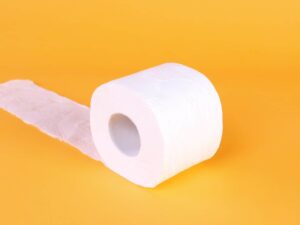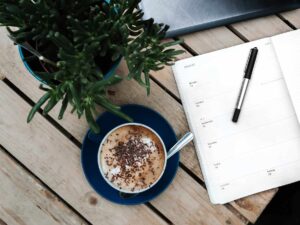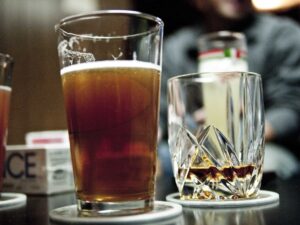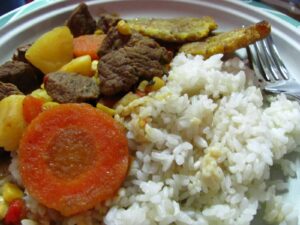Last updated on March 17th, 2023 at 04:32 pm
Anybody running long distances will eventually experience some stomach issues. Sometimes those stomach issues result in disaster for your times if you need to stop to use the toilet. Even worse, what would you do if there was no toilet around? Knowing how to stop runners trots is important for those of us wanting to limit bathroom issues on a run.

This post covers what runners trots are and how to stop them. In this post we cover seven primary ways to stop runners’ trots:
- Track your food intake
- Track your bathroom breaks during runs
- Limit insoluble fiber intake
- Limit sugar intake
- Avoid drinks that loosen your stool
- Eat foods that help solidify bowel
- Drink plenty of water
Read through the sections below to learn what foods and drinks put you most at risk to experience runners’ trots.
What are runners trots?
Runners’ trots, also referred to as runners’ diarrhea, describes the condition of loose bowel movements and a turning stomach during or following a run – most commonly a long run. Holding your bowels while running is difficult due to the jostling that occurs, and as a result runners trots is often characterized by multiple bowel movements.

Experiencing runners trots on race day can be a disaster.
With limited bathrooms around, finishing times in the balance, and spectators watching, you can find yourself in a real jam. This is one reason why it is important to learn how to stop runners trots before it is too late.

7 Ways to Stop Runners Trots
Below we breakdown how to stop runners trots. We explore avoiding specific foods, adding different food items to your diet, and doing some data tracking to make sure you find out what’s causing your bowel issues.
1. Tracking Food Intake
If you want to change anything about your workouts it starts with quality tracking.
Just like you track your daily mileage or the splits for your runs, you need to track food intake. This is important if you want to make any changes to the way you feel on your runs.
Tracking food intake is particularly important if you are experiencing stomach cramping and runners trots. While it likely makes sense to write down what has been eaten every meal of the day, we can start by focusing on less detail than that. Start by focusing on what was eaten the day before, and on the day of runs.
You should also make it common practice to note how you feel on your training log. For example, if you have a long run on Saturday make a note on your training log whether your stomach hurt, you had trots, or you felt great.
When you have been tracking the way you feel, as well as what you’ve been eating you can start to see patterns.
Maybe you will realize that there is one consistent food you have been eating that correlates to all the days your stomach hurts.
Tracking food intake, and how you feel on runs will allow you to make a slight change to your diet. This may end up being enough to stop your runners’ trots.
2. Tracking Bathroom Breaks
Just as it is important to track what food you have been eating it is equally as important to track when you use a bathroom during a run. This is extremely important if you want to make any connections between a food journal and your running experiences.

Tracking bathroom breaks for a period of time, and comparing these against your food journal can help you make some connections. Is that peanut butter sandwich correlating with all of your running cramps? Do you have to poop every time you eat eggs?
Everyone’s body is different. In order to know what is affecting your body tracking your personal food and workout data is an important step.
3. Limit Fiber Intake
Many of the foods we think about eating before running may actually make us poop on our run. Foods rich in fiber should be avoided. More specifically, insoluble fiber.
Insoluble fiber passes through your system without being digested, and as a result, this type of fiber adds mass to your stool. The increased mass, when combined with fluid intake, has been shown to increase the speed between food consumption and a bowel movement. Not a bad thing if you are constipated, but if you are embarking on your first 50-mile trail race it probably isn’t an exciting prospect.
Here are some examples of fiber dense foods to limit before races and runs:
- Apples
- Wheat Bran
- Peanut Butter
- Cauliflower
- Potatoes
Apples are particularly problematic for runners. They not only have a large amount of insoluble fiber, but they also are heavy in the soluble fiber, pectin, which is known to work like a laxative.
4. Limit Sugar Intake
We all know that too much of anything is bad. This is particularly true when it comes to sugar and running.
According to Harvard University, ingesting too much sugar will increase the likelihood of defecating. Sugar intake encourages your bowel to generate water and electrolytes, which have been proven to loosen your stool.
These effects aren’t limited to sugary snacks, cookies, and pastries. Many common fruits can cause similar gastrointestinal issues when mixed with running. Dr. Norton Greenberger, a Harvard Medical School professor, has pointed out that the fructose found in pears, apples, peaches, and cherries are just as likely to make you have a bowel movement as sugars found elsewhere.
Limiting sugar intake doesn’t mean you have to give up fruits and scones. Reducing how frequently you consume sugar, as well as when you eat those foods will help stop runners trots.
If you are going to eat a scone we would suggest waiting until after the trail marathon to do so.
5. Avoid Drinks that Loosen Stools
There are endless drinks available for consumption. This, however, does not mean we should freely consume any drinks we crave leading up to big races or runs. In fact, many drinks that are a main part of our routine may contribute to runners’ trots.
Below are some of the drink types we would suggest avoiding to help steer clear of bowl issues:

Avoid too much Coffee
Coffee is a cultural staple, and many runners love it. But coffee can impact more than your energy levels, it can impact your bowels. One effect of coffee is it increases contractions that occur in your bowel, which in-turn can wreak havoc on a run. Avoiding coffee before hitting the trails is one of the best ways to decrease the odds that you will have an intense urge to poop during your run. In fact, we dive into this topic further in our Is It Bad to Drink Coffee Before Running? post.
Avoid Alcoholic Beverages
Alcohol, like coffee, is a culturally important beverage. Not everyone drinks alcohol, but it is synonymous with social gatherings, and events like weddings. If you are a drinker, even a light drinker, and are experiencing runners trots you may want to remove alcohol from your diet.
When alcohol is consumed, the lining of your intestines become irritated. The resulting fluid that leaks into your gut compounds with the effects of increased contractions. This creates a more frequent urge to poop.
Removing alcohol from the equation can go a long way toward reducing the frequency of bowel movements during a run.
Avoid drinking Fruit Juice
We aren’t saying that fruit juice is bad for you. What we are saying is that many fruit juices are packed with sugar and fiber, which can activate your bowels and cause issues while running.
Remember, fruit juice often has way more sugar density than the same volume of actual fruit. The fact that it is liquid also makes its consumption very easy. This means you can consume a ton of sugar in a very short period of time.
Fruit juice can really wreak havoc on your bowels for the very same reasons sugar and fiber make bowel movements more frequent.
If a race is coming up, and you want to limit the activity of your bowels, eating whole fruit instead of fruit juice is a good start. Also, consider substituting fruit juice for good old plain water.
6. Eat foods that may help solidify bowel
There are plenty of foods you can eat in preparation for a race that won’t over activate your bowels. After all, proper nutrition is key to running in general. Some foods that do a good job of preventing bowel movements:
Bread
This obviously won’t help if you have a gluten issue, but breads low in insoluble fiber can be beneficial.
White Rice
Yes, brown rice has been less processed and has a number of benefits associated with it. That said, the additional fiber in brown rice may not make it the best choice for preventing or stopping runners trots.
Meat
Meat is low in fiber and many meat options are high in iron. This will help solidify your stool.
Whole Vegetables
Vegetables can help with healthy bowel movements BUT be aware of fiber levels for the varied veggies on your table.

Whole foods, in general, are a great place to start in developing healthy bowel habits. Develop a diet that your body responds to, and then tailor food consumption as race days and long runs approach.
7. Drink Plenty of Water
In addition to eating well, and avoiding foods and drinks that loosen your stool it is important to remember to drink water. Water should be the fluid you consume most unless directed by your physician otherwise. Staying properly hydrated is a good way to remain healthy. This goes for regulating your bowels as well.

Having a Healthy Bowel on Runs
We won’t always be able to make it through our runs without visiting a bathroom. That is an unrealistic expectation, and if you run frequently it is very unlikely. We can, however, work toward making fewer decisions that result in irritated bowels. This will go a long way in helping to stop runners’ trots. And, finally, if you must take a bathroom break mid-run, remember to leave no trace and pack our waste.

RELATED POSTS:
- Best GPS Watches for Trail Running
- Best Trail Races in the United States
- Best Waterproof Running Jackets
- Best Men’s Trail Running Shoes
- Trail Running vs Road Running Times
- Improve Lung Capacity for Running
Title Image Credit, 7 Ways to Stop Trots in Their Tracks: duk rae jo (source) Attribution 2.0 Generic (CC BY 2.0)— reduced file size and image
7 Ways to Stop Trots in Their Tracks, Image 1 Credit: Marco Verch Professional Photographer (source) Attribution 2.0 Generic (CC BY 2.0)— reduced file size and image
Image 2 Credit, 7 Ways to Stop Trots in Their Tracks: Marco Verch Professional Photographer (source) Attribution 2.0 Generic (CC BY 2.0)— reduced file size and image
Image 3 Credit, 7 Ways to Stop Trots in Their Tracks: Florida Fish and Wildlife (source) Attribution-NoDerivs 2.0 Generic (CC BY-ND 2.0)— reduced file size and image
7 Ways to Stop Trots in Their Tracks, Image 4 Credit: John Beans (source) Attribution 2.0 Generic (CC BY 2.0)— reduced file size and image
7 Ways to Stop Trots in Their Tracks, Image 5 Credit: Albert Leung (source) Attribution 2.0 Generic (CC BY 2.0)— reduced file size and image
Image 6 Credit, 7 Ways to Stop Trots in Their Tracks: EvelynGiggles (source) Attribution 2.0 Generic (CC BY 2.0)— reduced file size and image
Image 7 Credit, 7 Ways to Stop Trots in Their Tracks: istolethetv (source) Attribution 2.0 Generic (CC BY 2.0)— reduced file size and image
7 Ways to Stop Trots in Their Tracks, Image 8 Credit: Rick McCharles (source) Attribution 2.0 Generic (CC BY 2.0)— reduced file size and image

